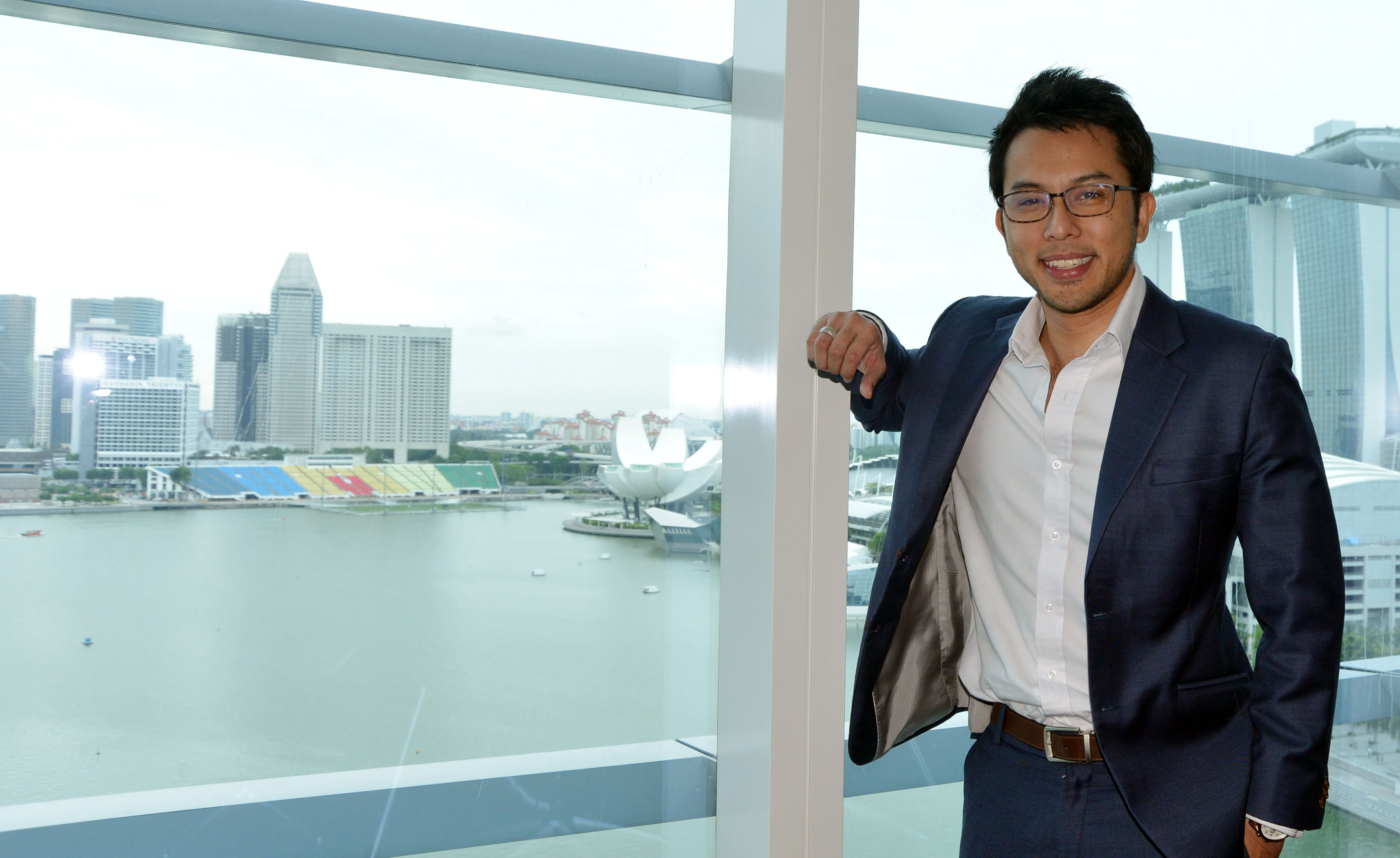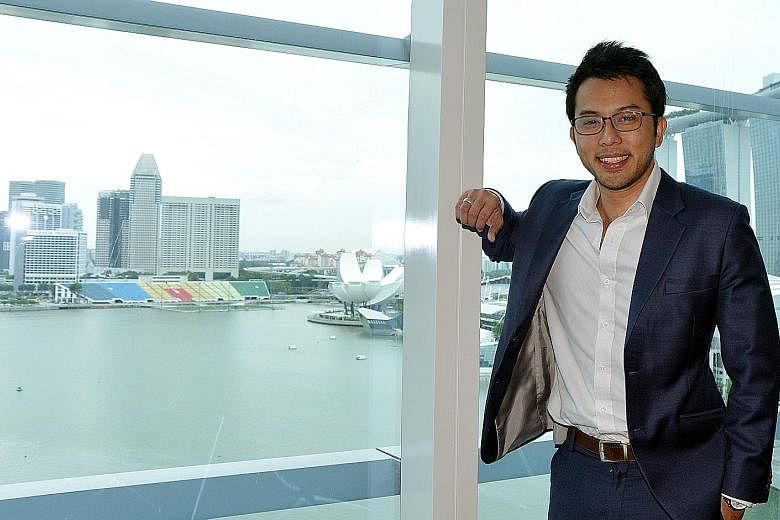It might seem unusual to associate meditation with the dapper Mr Nabil Mattar, who is dressed in a crisp white shirt and dark blue suit for this interview.
But meditation has played a major role in his personal trading skills, and is something he practises for 10 minutes every morning before his work as a director of premium client services begins at foreign broker IG.
Mr Mattar, 34, says: "It helps you to centre your mind. A lot of people don't see the link to trading. For example, if you made a loss or gain yesterday, you can't be emotional the next time you trade. Emotions skew things otherwise."
He started mediating 18 months ago, and notes it's something that billionaire hedge fund managers like Mr Ray Dalio also practise.
Mr Mattar finds that meditating with the aim to master his personal trading skills ties in very much with a Japanese philosophy called the Art of Zanshin that he subscribes to.

He describes it as "where one learns how to fall in love with the boredom of doing work and embrace each piece of the process instead of being too obsessed with the end result".
He discovered Zanshin - which also refers to "being in a state of relaxed alertness" - while reading a book about the "samurai way of trading" six years ago.
"Like a skilled archer, if we put the intensity, focus and sincerity into the process, then hitting the bull's eye is simply a side effect. This example applies exactly to trading as well. It's the process you enjoy, and it's not just about making big money.
-
Worst and best bets
-
Q What has been your biggest mistake with money?
A Stocks that I bought without knowing the risk, understanding the products and trends. The same thing goes for putting about $10,000 into soccer betting, in my university days.
I started from the Premier League and went into League One, which is below the Premier League and which I had little knowledge of.
As a young student, I got caught up in it and started to move into others like the German and Italian leagues. It was quite a lot of money for a university student, and my friends helped me realise it was not worth it.
This was also the same time I became interested in forex signals, which meant I was not investing in knowledge but just following advice.
I'm glad I made these mistakes when I was younger and had not much money. I've seen people who treat trading like gambling, and it can be dangerous.
Q And what has been your best investment move?
A The best investment is in myself. I quit my job as a relationship manager in a bank to give full-time trading a go in 2008.
Even though that did not turn out well, the time and money spent honing my skills and psychology as a trader are invaluable to my progress today.
Rachael Boon
"People cannot be too emotionally attached to the objective of making money, but should instead put the attention to the strategy and managing our own psychology.
"The reason why it is so difficult is because our lives revolve around results and money often, so how is it possible to detach yourself emotionally? That is where the constant psychological battle as a trader lies."
Mr Mattar enjoyed retail trading so much that he quit his banking job in 2008 to pursue it full-time, but returned to a regular job to build his capital.
He is accustomed to doing things differently from everyone, and even joined the My Paper Executive competition in 2013 - which looks for exceptional young working executives - and finished third.
Contrary to popular belief that trading in the markets is high-risk, "the biggest risk in trading is yourself", says Mr Mattar, who prefers trading foreign exchange and indexes. "You have all the tools to manage your risk such as guaranteed stop-loss orders, but if you don't manage your risk in yourself, you can end up 'killing' your trades."
Mr Mattar manages his risk by setting a maximum loss of between 1 per cent and 2 per cent, and a maximum drawdown of 10 per cent, among other things, for his personal portfolio. "Once I lose more than 10 per cent, I stop trading for a while and review things. These are risk-management techniques that you need to use."
The strategy he has honed over the years for himself gives him an edge over the markets,says Mr Mattar, but results came only after his "psychology matured as a trader".
"This comes with blood, sweat and tears, not chasing the markets, but learning how to refocus after a bad decision, knowing when to cut losses, which are all psychological elements of trading that are so important. I can say that trading is 70 per cent psychology."
Q Moneywise, what were your growing-up years like?
A My dad was in AIA for 30 years as an insurance manager, my elder sister Juliana and I were quite fortunate to grow up in an upper middle-class family. He always said not to keep up with the Joneses.
I've no debt and will think twice about buying a house. A lot of people here are "asset-rich, cash poor" but the assets aren't really assets because they are still paying for them.
Q How did you get interested in investing and trading?
A I started when I was in Singapore Management University, and bought stocks like Genting when there was a lot of talk about the casinos. I also bought some China stocks like China Hongxing Sports which is still suspended since it stopped trading five years ago. There was a time my portfolio was up 20 per cent when I was younger, but I kept holding on, and the 2008 crisis came and I suffered losses.
I later stumbled upon an overseas trading signal company. It turned out well for the first few months, but went downhill after that. I was just following someone's advice, but that's how I got started on trading. Eventually, when I lost enough money, I had enough and wanted to learn on my own.
Q Describe your personal strategy.
A To me, technical analysis is like the "eyes" of the markets. Everything you need to know as a trader is on the charts. What the momentum is, where the buyers and sellers are, how is the sentiment like - that's all revealed in the price action on the charts.
Price action is about studying the market without indicators, and I use it to determine the phase of the market - uptrend, downtrend or sideways.
I also use the support and resistance lines. These two are the leading indicators, and then I use lagging indicators like the exponential moving average and moving average convergence divergence. It's good to combine them.
I study the swing highs and lows of the market to have an overview of whether the market is trending or consolidating.
I steer away from trading in sideways markets because you don't want to be stuck when the markets are indecisive. For example, the euro has been trending sideways for a year or so, but if you look at commodities such as gold, it has been on a steady uptrend for the year.
Next, when I identify something interesting while studying the charts, I will drill down to specific timeframes to plan my trade.
When investing, people talk about buying low and selling high. As a trend trader, it's about buying higher on an uptrend, or selling lower on a downtrend, and is almost the opposite of value investing. My trades tend to be shorter-term.
Planning a trade is a process that involves deciding the timeframe that I personally plan to hold the trade for, the risk to reward, and also incorporating other indicators to build a trade plan.
Take the S&P 500 index. It's been moving sideways for the whole of last year and early this year. After Brexit, it broke the 2,130-point level a few weeks ago, which is the all-time high, and is an indication that the trend is starting to move up.
Once there is such a move on the chart, I zoom in to a four-hour or one-hour chart, and plan a trade to "buy up".
A lot of people are always questioning the fundamentals, and they also doubted if the S&P trend could be sustained. Being a pure technician means I will follow the charts.
After five years of trading for my own portfolio, this process of trade planning, using a similar price action strategy, has been ingrained in me and solidifies the trade planning process and strategy in order to achieve consistency.
I view the financial markets as one big jigsaw puzzle. The world is so connected now that when China sneezes, the whole world catches a cold.
To plan my personal trades, I scan different asset classes, from indexes, to commodities to foreign exchange, and look for the strongest trends.
I feel these are the markets that are easiest to trade as the direction and momentum have been established and, as a retail trader, all I aim to do is to "follow the tide".
Q What's in your personal portfolio?
A My trading portfolio consists of more than 30 different currency pairs and some eight different indexes.
As a technical trader, liquidity is of the utmost importance. Both foreign exchange and indexes offer the most liquidity in the market.
I've set aside a personal base capital of at least $50,000 for trading, and I plan to grow that to $100,000 in two years. I started achieving a consistent return of a low single-digit per cent each month some years ago.
The early years were painful. Like any amateur retail trader, I blew my account numerous times.
There's a common misperception that as a retail trader, you can be an instant millionaire. That is far from the truth. Trading is about getting rich slowly.
Now the returns from my own portfolio take care of my rent. That's more than enough for me, and I plan to slowly increase the lot size in future.
A new trader might catch a lucky break and make lots of money taking excessive risk, but with that kind of risk management, the market will catch up with him sooner or later. The key thing to trading is achieving consistency, which is a challenge that most people face.
Q What does money mean to you?
A Linking it to trading, you can't place too much weight or emotions on money. That's the tough part because it's about the "money culture" in Singapore.
When it comes to trading, you've got to be objective and that's the toughest part.
I also save 50 to 60 per cent of my income, and I spent the most on travelling because experiences are the currency of life.
Q What's the most extravagant thing you have done?
A In my books, it was an autographed boxing glove, with the signatures of boxing star Manny Pacquiao and his arch rival Floyd Mayweather, that I bought last year for about $3,000.
I was surprised, and was the only bidder. This was before the fight in May. It's not something I'd normally do. I was at an auction which had things such as sports memorabilia at a yacht show where I brought clients, and the wealthy people there were not interested. Based on my experience as a boxing fan, I think the value should at least increase threefold in the next decade or so. The last I checked online, it was selling for US$5,000 (S$6,690).
These are two legends, one is undefeated (Mayweather), the other (Pacquiao) has won in many weight classes, so in the next 10, 20 years, who knows what the glove's value will be. My plan is to keep it until they pass away, and I'll give it to my future son or something.
Q What are your immediate investment plans?
A My target is to achieve at least a consistent 5 per cent return a month for my personal portfolio.
My focus is on consistency, and once I am satisfied with my progress in the coming year, I will increase my capital in the account to achieve higher exponential returns.
Q How are you planning for retirement?
A Retirement is when I have the resources and capability to be a full-time trader in my own time. To be one I'd need at least $200,000 to $300,000 - maybe $100,000 for savings and the rest for trading.
I plan for contingencies first and own many insurance policies to ensure that my financial well-being is not hampered by unfortunate events. I also contribute monthly to a regular savings plan that is invested in a mutual fund. Other than that, most of my investments come from my trading.
Q Home is now...
A A condo in the east.
•The views expressed are Mr Mattar's own and and do not necessarily reflect the views of IG or related entities.


